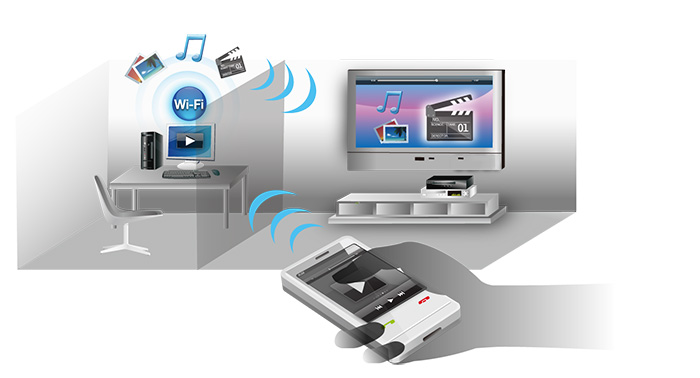With billions of DLNA-certified products on the market—including TVs, Blu-ray players, storage devices, media boxes, smartphones, tablets, game consoles and software—chances are good you already have more than one compliant device or application in your home. Depending on the manufacturer, the product may use a branded version of DLNA such as SmartShare (LG), SimplyShare (Philips), or AllShare (Samsung), but rest assured it’s all the same technology and it will all inter-operate.

DLNA support
First, please make sure that your TV supports DLNA, you can check your TV’s manual or search here:
DLNA configuration
Basically, the best way is to google a solution if your TV supports DLNA. For example, you can google “how to enable DLNA for Samsung TV” to learn how to enable DLNA for Samsung TVs.
DLNA needs a network
As you might expect, DLNA hardware is designed to work on a home network. It doesn’t matter whether that network is wired or wireless, although with Wi-Fi you’ll need to ensure that your network has sufficient bandwidth for what you want to do. We’d recommend 802.11n Wi-Fi for serious home sharing.
Please make sure that your TV is connected to your home network, as well as your phone.
DLNA is based on UPnP
DLNA-compatible devices use UPnP to communicate, and there are three classes of DLNA devices: Home Network Devices, Mobile Handheld Devices and Home Infrastructure Devices. The first category encompasses media servers, AV receivers, TVs, consoles and tablets; the second category includes smartphones and media tablets; and the third category covers routers and hubs.
Please ensure that UPnP is enabled on your router.
DLNA Certification means it’ll work
DLNA Certified devices have been tested to ensure that they’ll play nicely with other DLNA devices. Non-certified devices can be made DLNA compatible with software, so for example PCs can be DLNA servers if they’re running version 11 or later of Windows Media Player.
Still not connected?
Your TV does support DLNA, and is connected to your home network, and UPnP is enabled as well, but still can’t be detected and connected by our app?
Please make sure that your phone is using your home network WiFi (same as TV), not 3G/4G/5G network. And restart the service by tapping the upper left restart button. Sometimes waiting for a while will work.